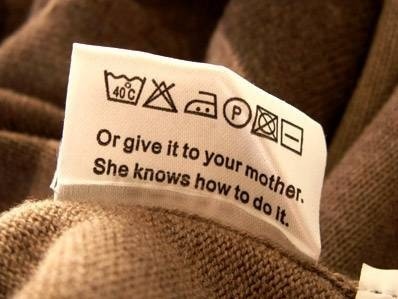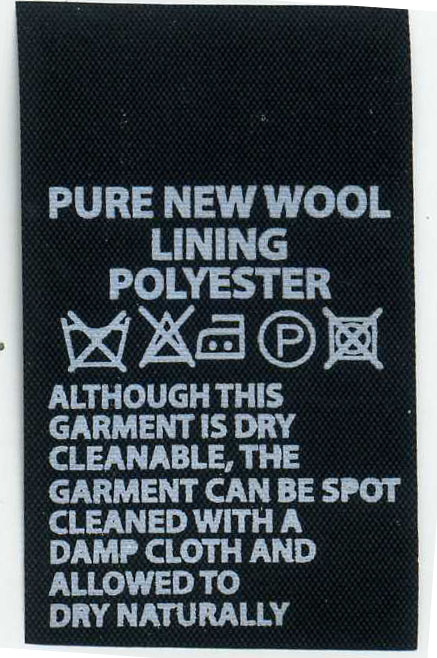Labels used on Textile Articles
Labeling on Textile articles, types, and standards
Symbols are written on labels, attached to textiles to indicate how a particular item should best be cleaned. Textile and apparel labels can help you consider alternative choices and make better buying decisions if you take time to read them. Permanent Care Labels (PCL) use symbols to explain how to care for wearing apparel and home sewing fabrics, so consumers need to learn the basic symbols.
What is on a Textiles Label?
All textile products (any product with 80 per cent or more textile content) have to be labelled with a range of information to inform the customer about the product’s care, safety, quality standard, size, fibre content (including percentage) and where it came from (country of origin).
With the increased demand for environmentally friendly products, textile items may also have recycling labels, eco-labels, organic and fair trade labels.
- Eco-Label: Found on an environmentally friendly product, awarded because of content or manufacturing system.
- Care Label: Label contains information on how to care for and maintain a product.
- Quality Label: Given to a product that has passed a standards test for the quality of the item or the system by which it has been produced.
- Safety Label: Shows the product has passed safety testing standards.
- Recycled Product Label: A product that has been reused in some form.
- Organic Product Label: Products produced using natural fertilisers, pesticides, and herbicides to protect the biodiversity of the environment and workers’ health.
Care Labelling
Care labels must be included so that a customer can care for the product correctly; if a customer fails to follow instruction this can affect their consumer rights. For example, if your machine washes a wool jumper and it shrinks in size but the label says handwash only then it is unlikely you will get it replaced if you take it back to the shop.
Quality and Safety Labelling
Textile products are often tested for safety and quality so that consumer can be confident in the product they are buying. These tests are carried out by either the British Standards Institute (BSI Kitemark) or to achieve the European Safety Standard (CE Mark). These tests not only test the quality of the product but also the manufacturing process: the manufacturer pays for the test and if the product passes they can fix the quality label to their product. Children’s products can undergo tests for safety, the Lion Mark for toy safety is a safety label awarded after testing y the British Toy and Hobby Association.
Eco-Labelling
In today’s world, it is important that manufacturers and consumers are aware of environmental effects on our planet, and the textile industry has to play its part. Consumers are attracted by eco-labels as they feel that they are doing their part to reduce adverse effects on the planet, and manufacturers are also under government pressure to conform to green policies. Eco-labels can be awarded if a product uses an eco-friendly system to produce the product or the product is made from recycled, sustainable, organic and natural dye sources.
Care Labels of Garments
Caring for garments in a proper way is so important that some regulations have been enacted requiring garment manufacturers to provide information about how to care for the garment. This information or care symbol must be attached to the garment and must be readable upon purchase. Such symbols are written on care labels, attached to clothing to indicate how a particular item should best be cleaned.
A Laundry care symbol is a standardized symbol which indicates best cleaning procedures to be used for that particular combination of fabric, thread, decoration and construction techniques representing a method of washing, bleaching, drying, ironing or dry-cleaning process of a garment.
Repeated cleaning treatment and correct care process can assure cleaner and fresher clothes, good appearance, longer life and most important, fit and quality of the garment. Damage to garments from incorrect cleaning methods can lead to complaints and costly customer return.
Qualifications of Good Care Labels
 At present various care labelling systems are followed worldwide. Whatever the system may be, it should follow basic principles as below.
At present various care labelling systems are followed worldwide. Whatever the system may be, it should follow basic principles as below.
- The care labels should not be visible from outside and should not be inconvenient to the wearer
- The symbols and letters on the labels shall be legible throughout the useful life of the garment
- All the symbols used in the care labelling system should be placed directly on the article or on a label which shall be affixed in a permanent manner to the article.
- Care labels should be made of a suitable material with resistance to the care treatment indicated in the label at least equal to that of the article on which they are placed.
- The care instruction symbols are applied to the whole of the garment including trimmings, zippers, linings buttons, embroidery or decorative embellishment.
Types of the care labelling system
 At present, there is no universal garment care symbol system. The ASTM symbols are accepted in NAFTA countries. ISO/GINETEX symbols are accepted in most of Europe, Asia, Australia and Japan has their own symbol system. Care labels are not mandatory in all countries. Following systems have been established as either a governmental regulation or an international standard.
At present, there is no universal garment care symbol system. The ASTM symbols are accepted in NAFTA countries. ISO/GINETEX symbols are accepted in most of Europe, Asia, Australia and Japan has their own symbol system. Care labels are not mandatory in all countries. Following systems have been established as either a governmental regulation or an international standard.
- Laundering is a process intended to remove soil or stains by washing with an aqueous detergent solution and possibly bleach and normally including subsequent rinsing, extracting drying.
- Chlorine bleach is a process carried out in an aqueous medium, during or after washing processes, requiring the use of chlorine-based bleaching agent for the propose of removing stains and improving whiteness.
- Non-chlorine bleach that does not release the hypochlorite ion in solution, for example, sodium perborate, sodium percarbonate, etc.
- Dry-cleaning is a process for cleaning textile articles by means of organic solvents like petroleum, per-chloro-ethylene, and fluorocarbon. This process consists or cleaning rinsing, spinning, and drying.
- Tumble drying is a process carried out on a textile article after washing, with the intention of removing residual water by treatment with hot air in a rotating drum.
- Ironing is a method or pressing using a heated hand iron sometimes together with moisture or steam, and gliding motion.
- Pressing Are a process or smoothing and shaping by heat and pressure, with or without the presence of steam.
- Bleach a product for brightening and aiding the removal of soils and stains from textile materials by oxidation that is inclusive of bother chlorine and non-chlorine products.
- Cleaning agent a chemical compound or formulating of several compounds which loosen, disperses, dissolves, or emulsifies soil to facilitate removal by mechanical action.
- Professional Care Cleaning and maintenance procedures requiring the services of a person specially trained or skilled in their use.
Care Label Symbols and Recommendations in PDF format
Wash-care Labels
Washcare labels play a vital role in the apparel industry by providing consumers with essential information on how to care for their clothing. These labels come in various types, each serving a specific purpose, and are crucial for garment longevity, consumer convenience, and preventing damage. Creating effective washcare labels involves considerations such as clarity, durability, and compliance with legal requirements, ultimately ensuring that consumers can enjoy their clothing items for years to come.
Apparel washcare labels are an essential component of clothing items, providing consumers with crucial information on how to properly care for their garments. These labels come in various types, each serving a specific purpose:
Fabric Composition Labels:
These labels specify the materials used in the garment’s construction. Common fabric compositions include cotton, polyester, silk, wool, and blends. Understanding fabric composition helps consumers make informed decisions based on their preferences and needs.
Washing Instructions:
Washing instructions are perhaps the most vital part of a washcare label. They provide guidance on water temperature, washing machine settings (e.g., gentle cycle), and any special care requirements (e.g., hand wash or dry clean only). Symbols are often used to convey these instructions universally.
Drying Instructions:
Drying instructions inform consumers about how to dry the garment properly. They may indicate whether tumble drying is safe, recommend line drying, or specify a flat drying method. Like washing instructions, symbols are often used to convey this information.
Bleaching Instructions:
If a garment can withstand bleach, the label will provide details on the type of bleach (chlorine or oxygen bleach) and any recommended dilution ratios. Garments that cannot be bleached will carry a “Do Not Bleach” symbol.
Ironing Instructions:
Ironing instructions specify the appropriate iron temperature settings for the garment. Some labels also provide additional guidance, such as ironing inside out or using a protective cloth.
Dry Cleaning Instructions:
For garments that require dry cleaning, labels will indicate this explicitly. They may also provide dry cleaning symbols, helping consumers understand the specific solvents or processes required.
Special Care Instructions:
Special care instructions address unique garment needs. This can include warnings about color bleeding, avoiding exposure to sunlight, or instructions for handling delicate embellishments or accessories.
Size and Brand Labels:
While not related to care, size labels help consumers find the right fit. Brand labels indicate the manufacturer or designer.
Environmental and Ethical Labels:
In recent years, some apparel brands have started including labels related to sustainability, such as organic materials or Fair Trade certification, to inform consumers about the environmental and ethical aspects of their products.
Importance of Apparel Washcare Labels
The significance of washcare labels in apparel cannot be overstated. They serve several crucial purposes:
- Garment Longevity: Proper care instructions help extend the lifespan of clothing items. Following the recommended washing, drying, and ironing guidelines can prevent damage and wear.
- Consumer Convenience: Washcare labels provide consumers with clear, concise information on how to care for their garments. This convenience saves time and effort and reduces the risk of accidental damage.
- Preventing Damage: Incorrect washing or drying procedures can lead to fabric shrinkage, color fading, or even structural damage. Washcare labels help consumers avoid these issues.
- Preserving Appearance: Garments often come with unique features like prints, embroidery, or delicate fabrics. Washcare labels guide consumers in preserving the appearance and quality of these elements.
- Safety: Labels that recommend against certain practices, such as ironing directly on prints or using bleach, help ensure consumer safety.
- Environmental Impact: Labels that promote eco-friendly practices, like using cold water or line drying, contribute to reducing the environmental footprint of clothing care.
Guidelines for Creating Effective Washcare Labels
Creating effective washcare labels requires careful consideration of various factors:
- Clarity: Labels should use clear language and internationally recognized symbols to ensure consumers understand the instructions.
- Durability: Labels should be securely attached to the garment to withstand multiple washes and wear. They should not fade or deteriorate easily.
- Placement: Labels should be placed in a conspicuous location, typically on the inside of the garment near the neck or waistline.
- Compliance: Brands and manufacturers must adhere to legal requirements regarding care labels, ensuring accuracy and completeness of information.
- Testing: Garments should undergo testing to determine appropriate care instructions. Testing may include washing, drying, and ironing to assess the garment’s resilience.
- Consumer Education: Brands can complement washcare labels with online resources or customer service to provide additional guidance and address specific queries.


